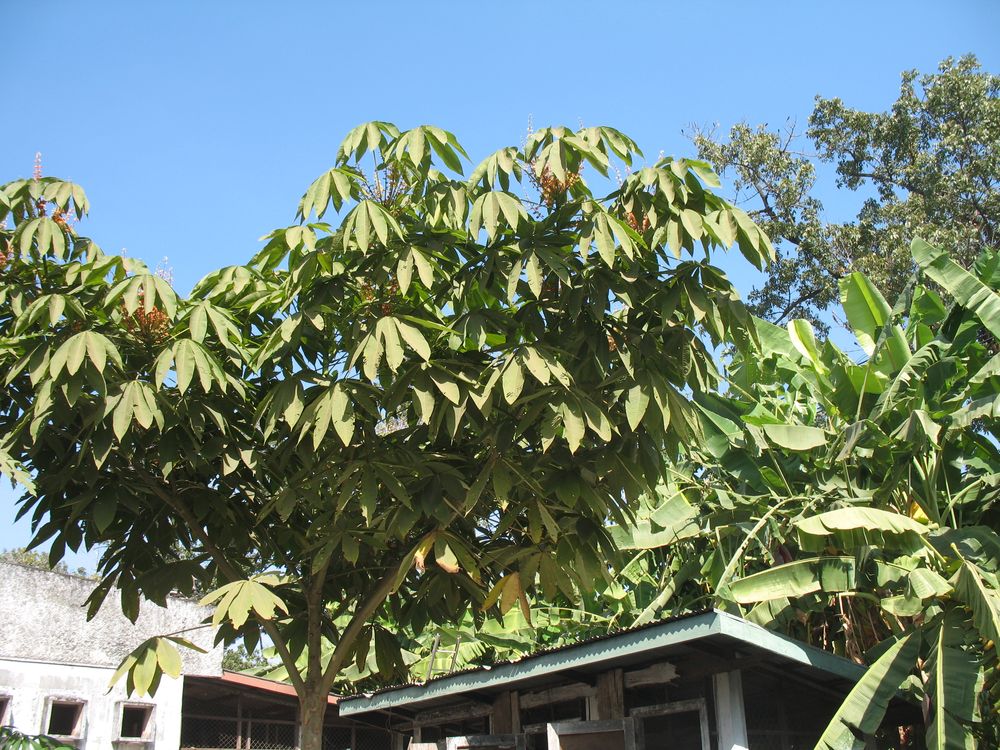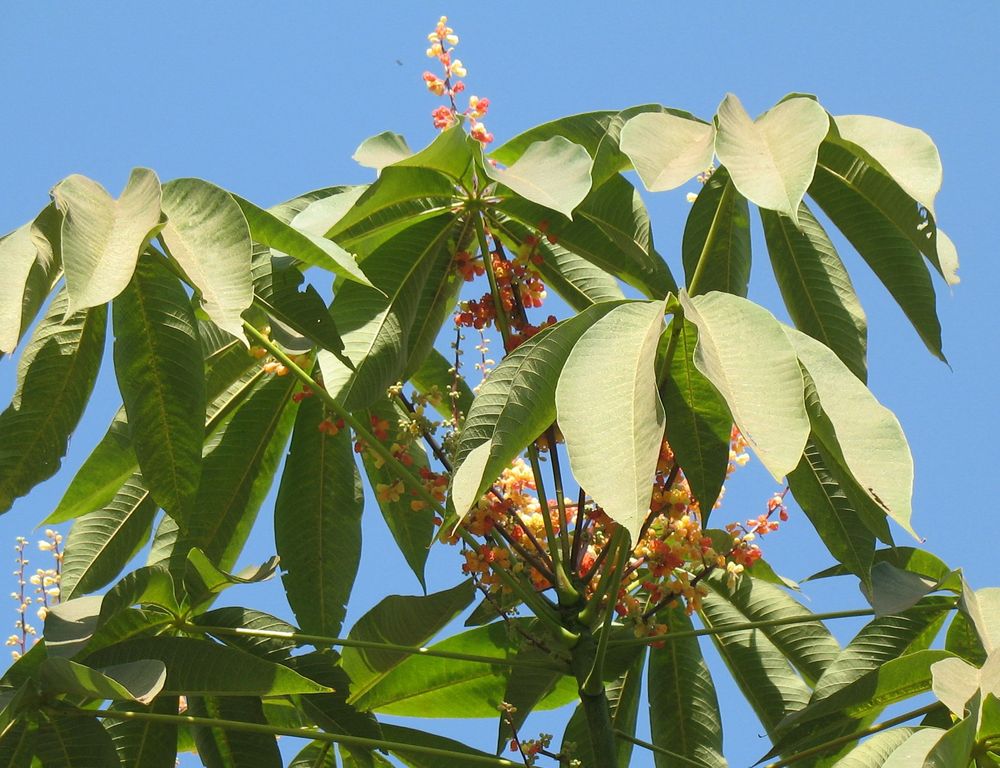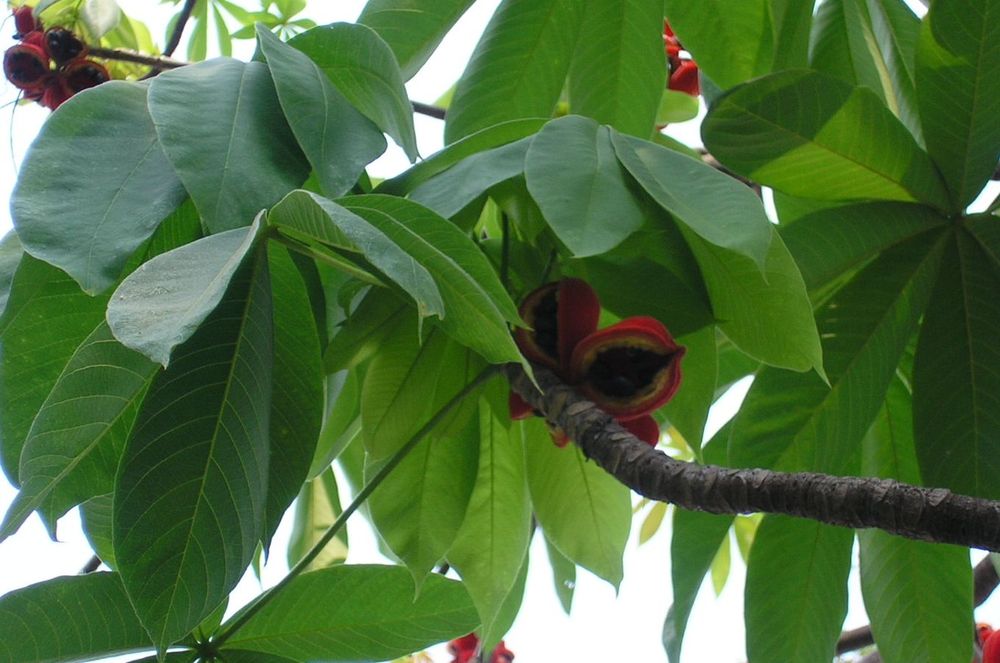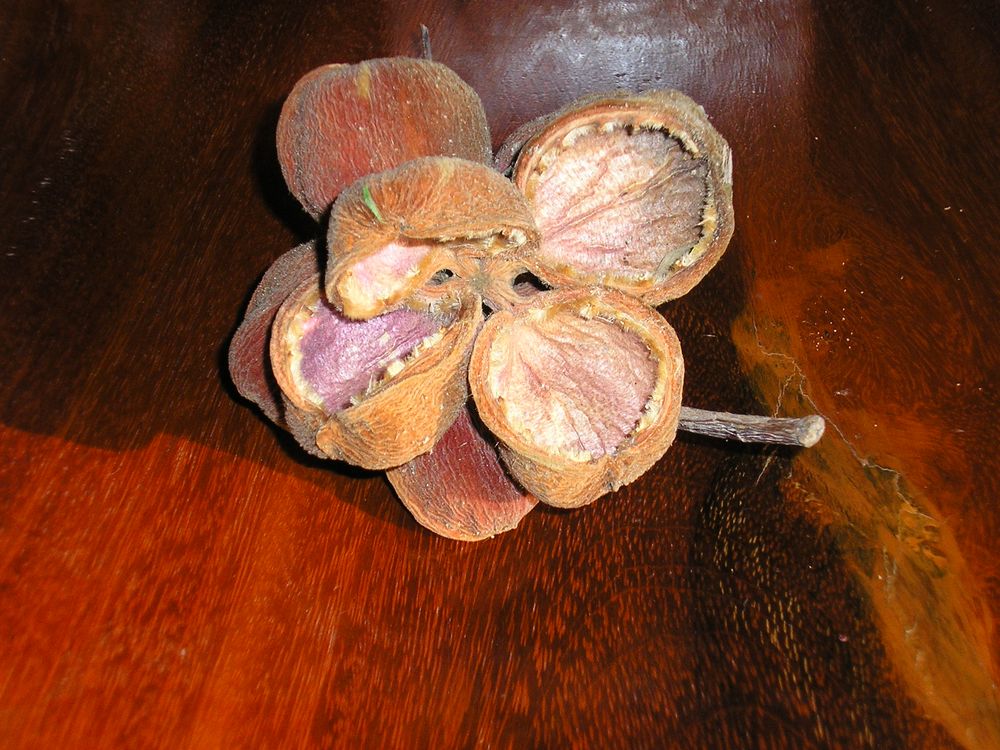Po is a generic Lao name for several plants that produce fibres: po sa, paper mulberry, po pan, China grass, and po deng, from which string is made. Po ban, or simply, po, is a tree approximately twelve metres tall, and seen frequently in villages and some urban gardens. It is particularly noticed and remarkable at the end of the dry season when its leaves fall and it is covered in downy, red fruit the size of a large lemon, which become brown when they age. Curiously, if you pick fruit that has fallen, you will have the unpleasant surprise of your fingers being covered with tiny, urticating hairs.
This tree is valued in villages, because, for want of synthetic string, its very fibrous bark, when cut into straps, serves to attach all that needs to be attached, and these barks, once dried, are sold in bundles in the markets and provide some income for the villagers.
The agronomists of the beginning of the last century have already noted that the seeds of this tree provide an oil which can be exploited and which was used by the villagers to give light. In 2009, a study ordered by the Lao government stated that a trade of these « nuts » existed in the Houaphan province which supplied a certain quantity to Vietnam; the study called for the planting of this tree in wide areas, since it grows rapidly and it also provides a lightweight wood for the fabrication of small pieces of furniture. The study ended by noting that in Laos, the extraction of the oil would be an important plus in value for the country.
Our investigations show that no part of this po is eaten; it is not the same as a close species, Sterculia foetida, the young leaves of which the Akha eat, despite their unpleasant odour. It is due to this odour, shared by numerous species of this genre, that these species are so-called, in reference to the Roman god of manure, Sterculius.
Po est un terme générique lao nommant plusieurs plantes qui donnent des fibres: po sa, le mûrier à papier, po pan, la ramie, po dèng dont on fait des cordes. Le po ban, ou plus simplement le po, est un arbre d’une dizaine de mètres assez fréquents dans les villages et dans quelques jardins urbains. Il est surtout remarquable et remarqué à la fin de la saison sèche car ses feuilles tombent alors et il se couvre de fruits rouges duveteux de la taille d’un gros citron qui deviennent bruns en vieillissant. Si, curieux, vous ramassez ces fruits tombés à terre, vous aurez la désagréable surprise d’avoir les doigts couverts de minuscules poils urticants.
Dans les villages cet arbre est précieux, car à défaut de liens synthétiques, son écorce très fibreuse, découpée en lanières, peut servir à attacher tout ce qui a besoin de l’être; ces écorces une fois sèches sont vendues en ballot sur les marchés et rapportent quelques liquidités aux villageois.
Les agronomes du début du siècle dernier avaient déjà noté que les graines de cet arbre fournissent une huile qui peut être exploitée et qui était employée par les villageois pour s’éclairer. Une étude commandée par le gouvernement lao en 2009 constate qu’un commerce de ces ‘’noix’’ existe dans la province de Houaphan qui en fournit une certaine quantité au Vietnam; le rapport préconise de planter sur de grandes surfaces cet arbre qui pousse rapidement et qui peut aussi fournir un bois léger pour la fabrication de petits meubles. Il termine en notant que l’extraction de l’huile au Laos même serait une plus-value importante pour le pays.
D’après nos enquêtes, aucune partie de ce po n’est mangée; il n’en n’est pas de même pour une espèce très voisine, Sterculia foetida, dont les Akha consomment les jeunes feuilles malgré leur odeur désagréable; c’est cette odeur qu’ont plusieurs espèces de ce genre qui lui a donné son nom en référence au dieu romain du fumier Sterculius.





Po is a generic Lao name for several plants that produce fibres: po sa, paper mulberry, po pan, China grass, and po deng, from which string is made. Po ban, or simply, po, is a tree approximately twelve metres tall, and seen frequently in villages and some urban gardens. It is particularly noticed and remarkable at the end of the dry season when its leaves fall and it is covered in downy, red fruit the size of a large lemon, which become brown when they age. Curiously, if you pick fruit that has fallen, you will have the unpleasant surprise of your fingers being covered with tiny, urticating hairs.
This tree is valued in villages, because, for want of synthetic string, its very fibrous bark, when cut into straps, serves to attach all that needs to be attached, and these barks, once dried, are sold in bundles in the markets and provide some income for the villagers.
The agronomists of the beginning of the last century have already noted that the seeds of this tree provide an oil which can be exploited and which was used by the villagers to give light. In 2009, a study ordered by the Lao government stated that a trade of these « nuts » existed in the Houaphan province which supplied a certain quantity to Vietnam; the study called for the planting of this tree in wide areas, since it grows rapidly and it also provides a lightweight wood for the fabrication of small pieces of furniture. The study ended by noting that in Laos, the extraction of the oil would be an important plus in value for the country.
Our investigations show that no part of this po is eaten; it is not the same as a close species, Sterculia foetida, the young leaves of which the Akha eat, despite their unpleasant odour. It is due to this odour, shared by numerous species of this genre, that these species are so-called, in reference to the Roman god of manure, Sterculius.
Po est un terme générique lao nommant plusieurs plantes qui donnent des fibres: po sa, le mûrier à papier, po pan, la ramie, po dèng dont on fait des cordes. Le po ban, ou plus simplement le po, est un arbre d’une dizaine de mètres assez fréquents dans les villages et dans quelques jardins urbains. Il est surtout remarquable et remarqué à la fin de la saison sèche car ses feuilles tombent alors et il se couvre de fruits rouges duveteux de la taille d’un gros citron qui deviennent bruns en vieillissant. Si, curieux, vous ramassez ces fruits tombés à terre, vous aurez la désagréable surprise d’avoir les doigts couverts de minuscules poils urticants.
Dans les villages cet arbre est précieux, car à défaut de liens synthétiques, son écorce très fibreuse, découpée en lanières, peut servir à attacher tout ce qui a besoin de l’être; ces écorces une fois sèches sont vendues en ballot sur les marchés et rapportent quelques liquidités aux villageois.
Les agronomes du début du siècle dernier avaient déjà noté que les graines de cet arbre fournissent une huile qui peut être exploitée et qui était employée par les villageois pour s’éclairer. Une étude commandée par le gouvernement lao en 2009 constate qu’un commerce de ces ‘’noix’’ existe dans la province de Houaphan qui en fournit une certaine quantité au Vietnam; le rapport préconise de planter sur de grandes surfaces cet arbre qui pousse rapidement et qui peut aussi fournir un bois léger pour la fabrication de petits meubles. Il termine en notant que l’extraction de l’huile au Laos même serait une plus-value importante pour le pays.
D’après nos enquêtes, aucune partie de ce po n’est mangée; il n’en n’est pas de même pour une espèce très voisine, Sterculia foetida, dont les Akha consomment les jeunes feuilles malgré leur odeur désagréable; c’est cette odeur qu’ont plusieurs espèces de ce genre qui lui a donné son nom en référence au dieu romain du fumier Sterculius.










Po is a generic Lao name for several plants that produce fibres: po sa, paper mulberry, po pan, China grass, and po deng, from which string is made. Po ban, or simply, po, is a tree approximately twelve metres tall, and seen frequently in villages and some urban gardens. It is particularly noticed and remarkable at the end of the dry season when its leaves fall and it is covered in downy, red fruit the size of a large lemon, which become brown when they age. Curiously, if you pick fruit that has fallen, you will have the unpleasant surprise of your fingers being covered with tiny, urticating hairs.
This tree is valued in villages, because, for want of synthetic string, its very fibrous bark, when cut into straps, serves to attach all that needs to be attached, and these barks, once dried, are sold in bundles in the markets and provide some income for the villagers.
The agronomists of the beginning of the last century have already noted that the seeds of this tree provide an oil which can be exploited and which was used by the villagers to give light. In 2009, a study ordered by the Lao government stated that a trade of these « nuts » existed in the Houaphan province which supplied a certain quantity to Vietnam; the study called for the planting of this tree in wide areas, since it grows rapidly and it also provides a lightweight wood for the fabrication of small pieces of furniture. The study ended by noting that in Laos, the extraction of the oil would be an important plus in value for the country.
Our investigations show that no part of this po is eaten; it is not the same as a close species, Sterculia foetida, the young leaves of which the Akha eat, despite their unpleasant odour. It is due to this odour, shared by numerous species of this genre, that these species are so-called, in reference to the Roman god of manure, Sterculius.
Po est un terme générique lao nommant plusieurs plantes qui donnent des fibres: po sa, le mûrier à papier, po pan, la ramie, po dèng dont on fait des cordes. Le po ban, ou plus simplement le po, est un arbre d’une dizaine de mètres assez fréquents dans les villages et dans quelques jardins urbains. Il est surtout remarquable et remarqué à la fin de la saison sèche car ses feuilles tombent alors et il se couvre de fruits rouges duveteux de la taille d’un gros citron qui deviennent bruns en vieillissant. Si, curieux, vous ramassez ces fruits tombés à terre, vous aurez la désagréable surprise d’avoir les doigts couverts de minuscules poils urticants.
Dans les villages cet arbre est précieux, car à défaut de liens synthétiques, son écorce très fibreuse, découpée en lanières, peut servir à attacher tout ce qui a besoin de l’être; ces écorces une fois sèches sont vendues en ballot sur les marchés et rapportent quelques liquidités aux villageois.
Les agronomes du début du siècle dernier avaient déjà noté que les graines de cet arbre fournissent une huile qui peut être exploitée et qui était employée par les villageois pour s’éclairer. Une étude commandée par le gouvernement lao en 2009 constate qu’un commerce de ces ‘’noix’’ existe dans la province de Houaphan qui en fournit une certaine quantité au Vietnam; le rapport préconise de planter sur de grandes surfaces cet arbre qui pousse rapidement et qui peut aussi fournir un bois léger pour la fabrication de petits meubles. Il termine en notant que l’extraction de l’huile au Laos même serait une plus-value importante pour le pays.
D’après nos enquêtes, aucune partie de ce po n’est mangée; il n’en n’est pas de même pour une espèce très voisine, Sterculia foetida, dont les Akha consomment les jeunes feuilles malgré leur odeur désagréable; c’est cette odeur qu’ont plusieurs espèces de ce genre qui lui a donné son nom en référence au dieu romain du fumier Sterculius.


